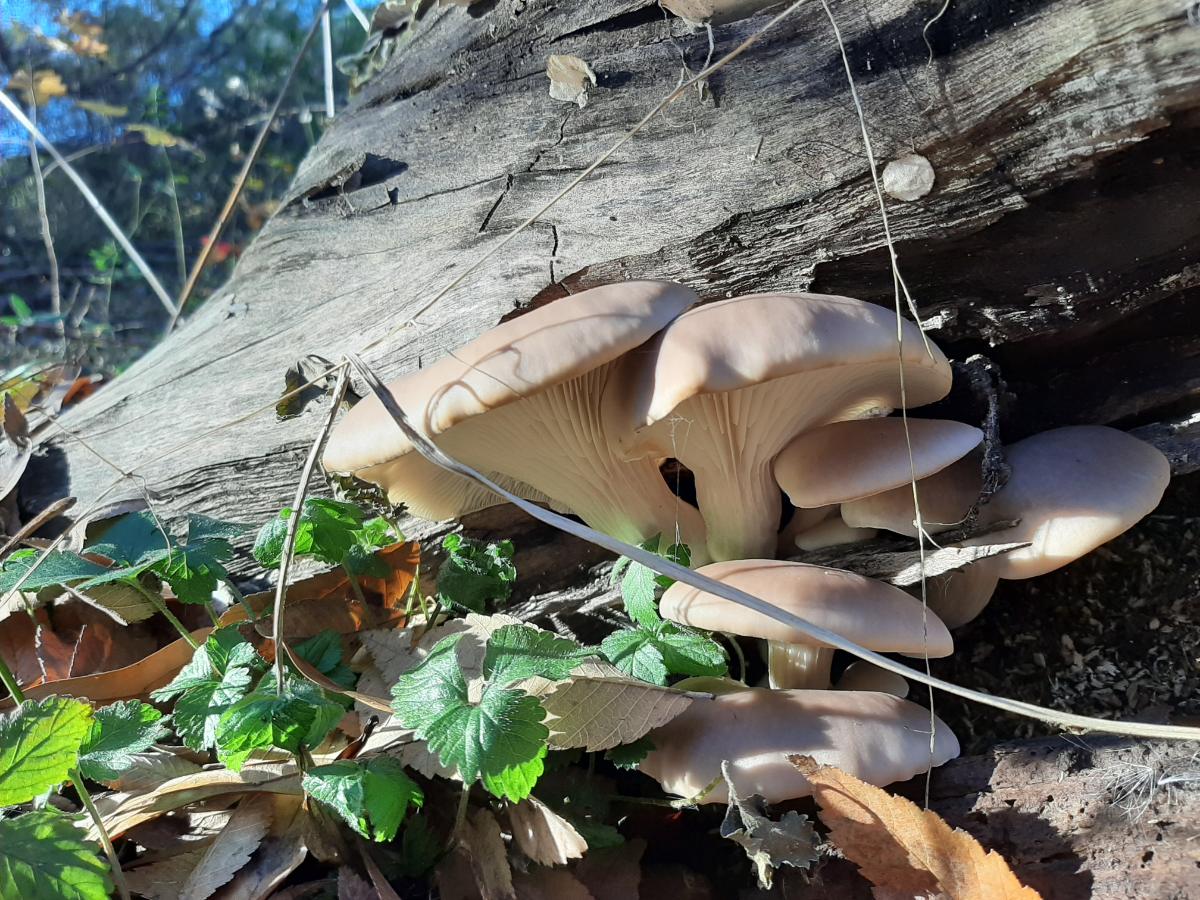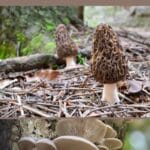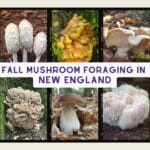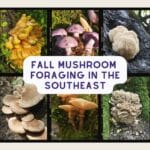Foraging mushrooms at any time in the southwest takes some patience, knowledge, and preparation. The fungi aren’t just popping up everywhere like in other parts of the country. Spring mushroom foraging in the southwest means waiting for snowmelt and heading to the mountains.
This part of the country is wild and unique, with contrasting environments, from deserts to super tall mountains. All the planning is usually worth it, though, as there are some fabulous edible mushroom species fruiting in the southwest in spring, including morels, oysters, and shaggy manes.
The success of your foraging forays depends significantly on where you live or how far you’re willing to drive. In the low desert, you’re not going to find much. Spring mushroom foraging in the Southwest requires flexibility and close monitoring of weather conditions. You’ll want to track snowmelt and the temperatures and conditions in the mountains. If you’re in the desert, make sure it’s actually safe to drive to the higher elevations.

Many mushroom species have been waiting for the snowmelt and intermittent rains so they have enough moisture to fruit. They also like the warmer temperatures as winter moves into spring. Most mushrooms take a day or two to appear, though, so the best practice is to go out searching 2-3 days after a rainfall. The best places to look are cottonwood washes, forested mountains, riverbeds, creek bottoms, and landscaped areas.
The lack of bug damage is a bonus to southwest foraging that other regions don’t have—it’s easier to find mushrooms in good condition, though potentially a bit dried up. The fungi may dry out on the ground or tree, but rarely are they so infested with bugs that they are beyond collecting.
Spring hikes are a great time to explore new areas and find new foraging spots. Keep an eye out for old and decomposing mushrooms, too. An old deteriorating oyster mushroom was once in its prime. Mark that spot and check again later in the year, and you might be rewarded.
If I’m missing any southwest spring mushrooms, please let me know in the comments! And check out the seasonal guides: Winter Mushroom Foraging in the Southwest, Summer Mushroom Foraging in the Southwest, and Fall Mushroom Foraging in the Southwest.
Jump to:
Top Three Spring Mushrooms In The Southwest
Morels (Morchella)
The much-sought-after morel grows in the mountains and the lowlands. There are several different species of morels, but they’re all delicious and an awesome foraging find. In the lowlands, you’ll find morels around cottonwoods and riparian areas. In the mountains, there are burn morels. Morel season starts in mid-April but really picks up in May and June when the higher elevations warm up, and all the snow has melted.
The distinguishing characteristics of morel mushrooms include a cap with pits and ridges, a whitish stem, and a hollow interior. The size of morels differs significantly between species, but in general, they’re between 1 and 5 inches tall. The cap attaches to the stem in the middle or at the top of the inside of the cap.

The beloved morel mushroom is a fungi gem that only fruits in the spring. Unlike many other mushroom species, morels do not grow at any other time of the year. So, if you want to find morels, you must get out in the woods in April – May and dedicate some time to the hunt.
Hunting morels in the Southwest can be very challenging. You need to consider many factors, including the slope, soil temperature, tree species, and whether or not the area has been recently burned. Morels are not easy to find in the Southwest—they’re picky about their habitat and need specific temperature and moisture conditions. Some years, they barely make a showing.
Morel season starts in lower elevations, where it’s warmer. Then, as the weather warms at higher elevations, they fruit there. Elevation extends the morel season sometimes into July, but the prime season for hunting them is May. Parts of southern California will see morels in February and early March, but these are usually landscape morels, which don’t follow the same fruiting rules as other morel species.

The best place to look for morels in the southwest is around burn sites in the mountains as soon as the ground and temperature warm up. Morels like a cold, wet winter, so if your region did not experience this, the hunt will likely be a frustrating one. Yellow morels sometimes fruit in riparian areas in the high desert, growing under cottonwood trees from late March to early May. They are pretty rare, but it’s worth looking if you’re nearby.
One of the great things about morels is that they usually reappear in the same location year after year. So, once you find a spot, mark it well and visit it yearly to harvest. If you’ve found burn morels, they tend to fruit in the burn zone really well the first year, pretty good the second year, and then start to peter out. Hunting burn morels means shifting locations a lot.

Every year is different, some slower or later than others, and some earlier. It all depends on the winter weather, current climate, rainfall, and overall temperatures. Further down, you can see that even though the timing may vary, it has actually been pretty consistent over the last several years.
Many folks just start hitting the woods and checking their spots in mid-April. This works well, too, since that is historically the real start of the season. You can also pay attention to the weather and get yourself a soil thermometer. Morels usually start showing up when the daytime temperatures are above 40F, and nighttime temperatures are in the 40s. The ideal soil temperature is between 45-55F.
The Facebook Group Morel Mushroom Find Reports is an excellent and reliable resource. The Morel Sightings Map, which is updated annually, is another great way to see where people are finding morels.

To give you an idea of the difference over the last several years, here are the first Morel sightings in the Southwest as reported on the Morel Sightings Map.
- 2024 – no reports yet (as of 3/8/24 – will update when there is a sighting reported)
- 2023 – last week of April, but mostly May
- 2022 – first week of April, but mostly May
- 2021 – last week of April, but mostly May
- 2020 – end of March
- 2019 – mid-April, but mostly May
- 2018 – last week of April, but mostly May
An important point to consider when foraging morels (and any mushroom, really) is that elevation matters. This is especially true in the Southwest, where there are some pretty extreme elevation changes. Experienced foragers follow the morels up the mountains as the weather progressively warms on the mountaintops. This extends the season quite dramatically and can have you finding morels into June and July in cooler, higher-elevation areas.
When searching for morels in the Southwest, the best places to look are around cottonwoods in high desert areas and burn sites in conifer forests. The list below shows the range of habitat preferences depending on the species, but there is also a lot of overlap. In the Southwest, you may come across 12(!) different species of morels: two yellow morel species, nine black morel species, and one white morel species.

- Morchella americana – a yellow morel that grows with ash, elm, cottonwood, apple, and pear trees, among others. Looks gray when young, then develops yellowish brown ridges and pits.
- Morchella importuna – a black morel also known as the landscape morel, this species grows in landscaped areas like gardens, parks, and disturbed ground. Large species with dark brown ridges and yellowish-brown pits when mature. Early sightings of morels are usually of this species. Range is currently California and Nevada and likely spreading.
- The burn-site morels – four species of black morels grow exclusively in burned-out conifer forests. They appear in the spring after a fire and often for several years afterward, too.
Oyster Mushrooms (Pleurotus)
The cool-weather-loving gray oyster mushrooms (Pleurotus ostreatus) have been fruiting all winter long, and as the seasons continue into spring, they will also continue growing. However, they may only hang out in early spring since they don’t like super warm weather. These are often a year-round species in areas of the Pacific Northwest, depending on the region and the climate conditions that year. But they are less common in the heat and humidity of summer. P. ostreatus is most likely encountered in the first couple of months of spring.

These oyster mushrooms have light brown caps, white to buff gills, and dense white flesh. They grow on deciduous hardwoods (trees that lose their leaves). Beech and aspen trees are common. Sometimes, they grow on conifers as well. Oyster mushrooms have a mild anise odor, meaning they smell a little sweet, like licorice. They tend to get bug-infested, so don’t wait to harvest them if you see them.
The aspen oyster mushroom, also known as the spring oyster, is a typical springtime find. It fruits primarily on quaking aspen trees but can also grow on other aspen species and cottonwoods. Aspen oysters smell faintly of anise or might have a subtle mushroom scent.

Veiled oyster mushrooms are generally winter mushrooms, but they still might be fruiting in early spring. They like cool to mild climates and grow on dead and dying hardwood trees. Veiled oyster mushrooms look different from other oyster mushrooms because they have a veil around the gills and usually grow alone instead of in dense clusters.

The Phoenix oyster mushroom is the opposite of the cooler-weather preferring gray oyster, aspen oyster, and veiled oyster. This one starts showing up as soon as the weather warms up, often from mid-April all the way through September. The gray oyster, P. Ostreatus, is more of a winter to early spring species, while the Phoenix oyster mushroom is a late spring to summer oyster mushroom species.

Shaggy Manes (Coprinus comatus)
The tall, stately, shaggy mane is a prime spring species. It has a long cylindrical cap that is very unique, and the way it disintegrates into an inky black mess with age is bizarre. Shaggy manes are part of the Coprinoid family, the inky caps, which quickly decompose into black goo. If you find these in prime condition, harvest them immediately. Even just a day later, and they might start decaying.
Shaggy manes are found in fields, grasslands, and meadows. They do not grow from wood or logs. They’re often found on the side of roads, trails, or areas where the ground has been disturbed. They commonly grow in vast, dense groups. Where there’s one, there’s usually dozens.
These mushrooms have a light, mild flavor that’s great but gets easily overwhelmed. If you add too many strongly flavored ingredients, you won’t be able to taste them. They’re best in a simple recipe where their flavor can shine.

Spring Is Investigation Time!
Spring is the ideal time to scope out new foraging locations. In spring, I take my time in the forest to gather clues for the summer and fall foraging expeditions. Be observant and aware of your surroundings and you might discover some incredible locations to check later in the year.
One thing that is really useful is to pay attention to the trees, not just the ones you are searching for morels around. Take note of old growth Ponderosa pine and Bishop pine forests and thick forest duff. This is prime habitat for many edible boletes, like the king bolete (porcini).
Before the underbrush grows so thick you can’t see through it, look around. You may spot things that will be hidden by underbrush later in the year. For instance, I discovered an old chicken mushroom rotting on a log. Knowing that they come back to the same spot every year, I marked that location.
During chicken of the woods “season” I would never have seen this one because of all the underbrush. In fact, I’m sure I passed by the spot several times in prime chicken season without ever seeing it. Use the current conditions to your advantage and mark down spots to visit later in summer or fall for other mushroom species.
Mushroom Foraging Resources
If you’re new to mushroom foraging, here are some great guides to get started: How To Be A Successful Mushroom Forager, Mushroom Foraging 101, and Mushroom Identification Pictures and Examples.
This guide to the best identification books by region will help you find the best guides for you.
Curious about spring foraging in other areas? Check out our guides for across the US.









Leave a Reply